

I plan to make this post the first in a series on technique and medium. Paint. The stuff that gets under the artist’s fingernails, and can barely be scrubbed away. I love paint. I love color. I love walking up to a painting and trying to decipher its DNA. I live with a painter and the studio I know is filled with jars of paint, so much so that it looks like the workshop of an alchemist. Most painters’ studios that I’ve visited have that look of transformation about them. Colors get mixed, blended, spilled. Art gets made, or it doesn’t.
I decided to start “Different Strokes” in kind of the middle of the last century because I’ve been spending time at SAAM looking at the work of the Abstract Expressionists and the influential New York School of Painting that just exploded after WWII and changed the landscape of art and the way we see things. How do we like paint? Some like it thick, as in the way Hans Hofmann laid down colors (he’s next!); others prefer it in Jackson Pollock drips, while others swear by the colorful, meditative blocks of Rothko. Right now, however, I want to start with the paintings of Helen Frankenthaler, whose painting Small’s Paradise holds its own on the third floor. This lovely work, as evocative as an Indian raga (a term that refers to music composed for different hours of the day, so spiritually akin to Frankenthaler’s painting) is not just about its subject—a jazz bar in Harlem. It’s also about the painterly way she painted.
Frankenthaler invented a new technique that became known as the “soak stain method.” Rather than priming the canvas, she jumped right in and soaked the canvas with diluted paint. Her painting gives the viewer, at least this one, the feeling of swimming in the artwork. It allows the abstract shapes to flow and create an image that feels just as much an homage to the natural world as it does to abstraction. In Small’s Paradise the green gives both the sense of a proscenium stage as well as a garden wall. The colors flow, change depth, and allow you to enter the painting, and it’s up to the viewer to figure out if s/he’s walking into a garden, a jazz club, or a space that’s just come into being.

















